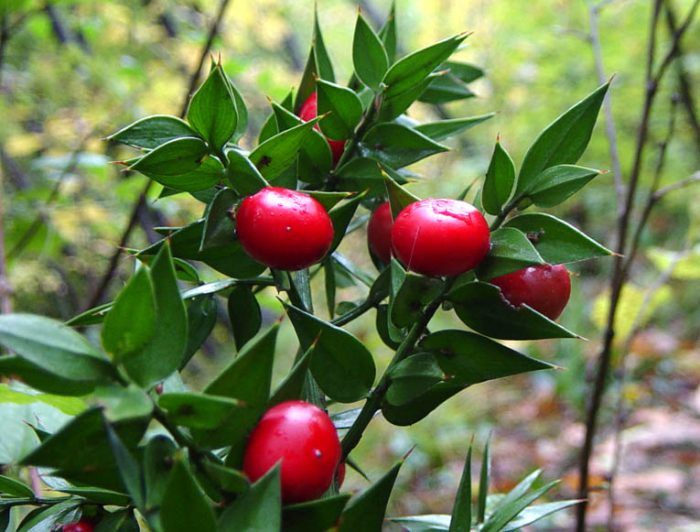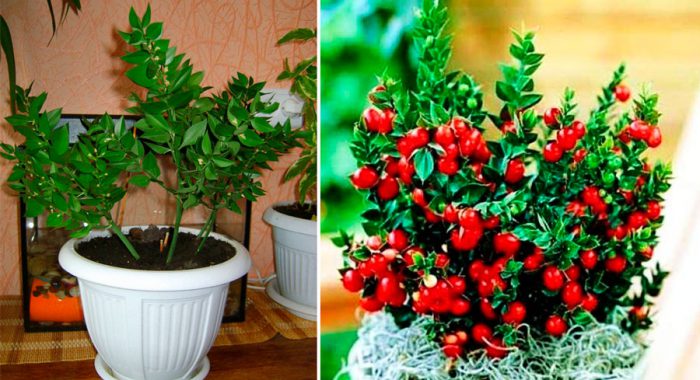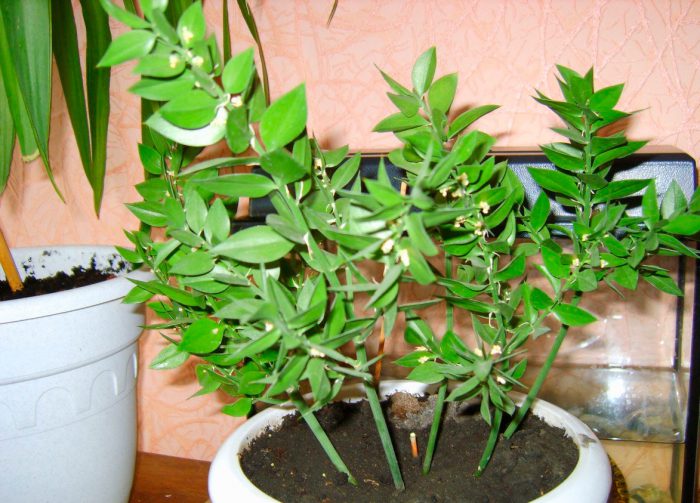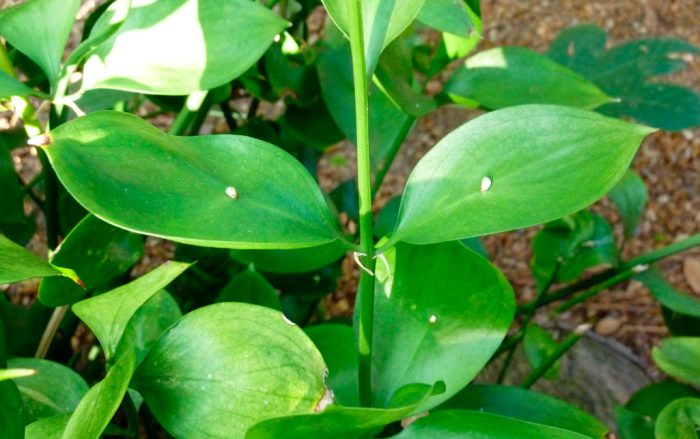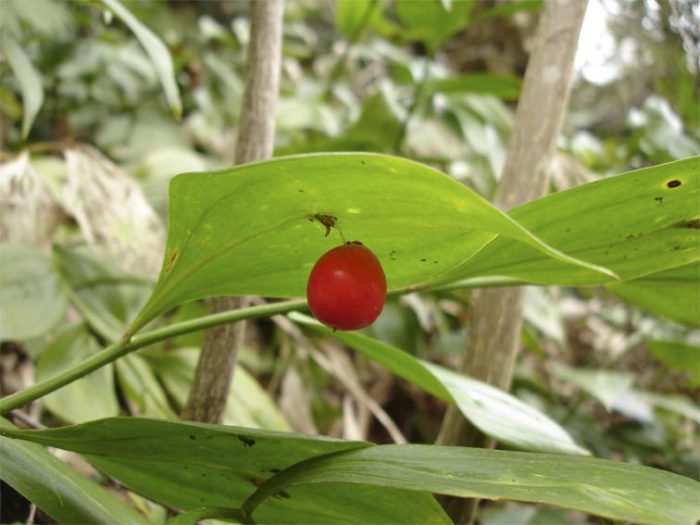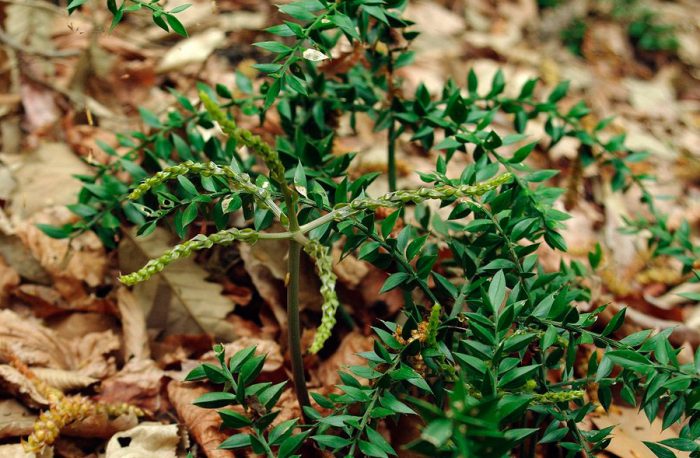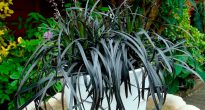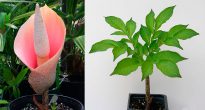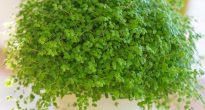Ruscus (Ruscus), which is also called butcher, is directly related to the Asparagaceae family. However, there are sources in which this plant is allocated to its own family of butcher's (Ruscaceae) or it is included in the family called liliaceae.
Such a domestic perennial plant as butcher has a very spectacular appearance. Differs in a non-capricious character and undemanding care. Can grow in shaded areas. Most often, growers grow Ruscus as a compact bush, but it can also be decorated as a lovely Christmas tree. During fruiting, almost the entire plant is covered with round berries of a deep red color. Since this flower is unpretentious, it is often chosen to decorate not only apartments, but also offices. The tough stems of this flower are colored dark green. After cutting, they do not lose their spectacular appearance for many months, so Ruscus is quite suitable for composing various compositions.
In the wild, butcher's broom can be found in the pine and oak forests of Western Europe, in the Crimea, the Caucasus, as well as in southern Russia.
This flower can grow up to 70 centimeters. Spear-shaped prickly leaves are nothing more than modified flat stems, which experts call cladodia (phyllocladia). The scaly leaves are very small.
In spring, flowering begins, but the rather plain flowers do not represent any decorative value. However, berries appear from the pollinated flowers, which after ripening acquire a rich red or orange-red color. The fruits do not fall for a long time. Therefore, on the same bush, there can be both flowers and fruits. As a result, you may get the impression that the butcher's flowers and bears fruit constantly. For fruits to appear, female and male plants are needed. But often the fruits can form on the butcher, which grows alone.
Butcher's care at home
Caring for such a plant is quite simple. Remember that intensive growth and development in Ruscus occurs exclusively in the spring. At this time, fully formed young shoots begin to grow. And what they will be, depends on the dressing, as well as watering. This plant must be handled very carefully.The fact is that if the shoots are damaged, the young will be able to grow back only with the onset of the next spring period.
Illumination
Diffused light is needed, but feels fine in a shaded place. In winter, it is recommended to put on the window sill a window located in the southern part of the room, and in summer - in the east or west. Remember that the direct rays of the sun in the summer can destroy the butcher (it will dry out).
Temperature regime
In the spring and summer, the plant needs a normal room temperature, and it is best to move it outside. In winter, it needs coolness (constant temperature 13-15 degrees). Therefore, butcher is suitable for growing in lighted halls as well as cool foyers. There are also frost-resistant species that can be used to decorate the house from the outside.
Humidity
Does not require a certain humidity. Experts advise to systematically spray the ruscus, and also wash to remove dust.
How to water
During the active growth of young shoots, the plant needs systematic watering. After, when growth stops, it will be able to withstand the lack of watering.
Top dressing
Top dressing is carried out during active growth 1 time in 3 or 4 weeks. To do this, use a complete complex fertilizer. In winter, the plant has a dormant period, and it is impossible to feed it at this time.
Transplant features
The transplant is carried out in the spring as needed. The shape of the future bush depends on the choice of the pot. So, if you want to get a lush bush, then you should choose a wide pot. In it, young shoots are quickly formed from the creeping rhizome at the butcher's. In a narrow container, the ruscus will not be bushy.
Earth mix
Does not need nutrient-rich soil, as it prefers to grow on mountain slopes in the wild. However, the substrate should not be too dense, as stagnant water in the soil should be avoided. To make a soil mixture suitable for butcher's, you need to combine leaf and turf soil, as well as sand in a 3: 1: 1 ratio. Dried old underground shoots should be removed during transplanting.
Reproduction methods
You can propagate by seeds or by dividing the bush. The second method is the easiest. The division of the rhizome of an overgrown old plant is carried out in the spring. Each section should have roots and shoots. Remember that the transplant is carried out before the active growth period begins.
Diseases and pests
Not too susceptible to diseases and pests. Can settle thrips, scale insects, as well as spider mites.
Video review
Main types
Butcher's broom (Ruscus aculeatus)
Reaches a height of 60 centimeters (in some cases 100 centimeters). Has erect shoots. Lanceolate, leathery phylloclades are gray-green. They are also drawn into a spiny long point, you can clearly see the midrib. Fruits of a rather large size are colored red. Ripening occurs in November or December.
Butcher's leaf (Ruscus hypophyllum)
Most often in natural conditions, it is found in the Transcaucasus and the Mediterranean. It prefers to grow under the forest canopy. In this regard, in room conditions, it can grow quietly in the shade. It reaches a height of 50 centimeters. Glossy phylloclades are oblong-lanceolate and taper towards the base.
Butcher Colchis (Ruscus colchicus)
It has large phylloclades, and its stem does not branch. Blooming of flowers occurs gradually throughout the entire autumn-winter period. And with the onset of spring, the fruits ripen. This type is medicinal.
Buttock sublingual (Ruscus hypoglossum)
The bush reaches a height of only 30-40 centimeters. This species is listed in the Red Book. In the wild, it can be found in the south of Crimea, as well as in Europe, where this plant prefers to grow in shady damp forests on damp rocks and between stones. In leathery phylloclades, which are also glossy, the top has a rounded shape.
Buttock hyrcanus (Ruscus hyrcanus)
In nature, it can be found in northern Iran and the Caucasus. It is a relict plant. Prefers to grow in mountain forests as a solid carpet. It reaches a height of 25-40 centimeters.

